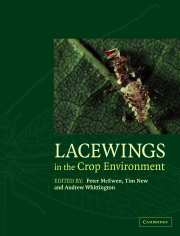Book contents
- Frontmatter
- Contents
- List of contributors
- Preface
- PART 1 Lacewing systematics and ecology
- PART 2 Lacewings in crops
- PART 3 Principles
- PART 4 Case studies
- Introduction to Part 4
- CHAPTER 18 Micromus tasmaniae: a key predator on aphids on field crops on Australasia?
- CHAPTER 19 Preliminary notes on Mallada signatus (Chrysopidae) as a predator in field crops in Australia
- CHAPTER 20 An evaluation of lacewing releases in North America
- CHAPTER 21 Chrysoperla externa and Ceraeochrysa spp.: potential for biological control in the New World tropics and subtropics
- CHAPTER 22 Comparative plant substrate specificity of Iberian Hemerobiidae, Coniopterygidae, and Chrysopidae
- CHAPTER 23 Lacewings in Sardinian olive groves
- CHAPTER 24 Lacewing occurrence in the agricultural landscape of Pianura Padana
- CHAPTER 25 Lacewings and snake-flies in Piedmont vineyards (northwestern Italy)
- CHAPTER 26 Control of aphids by Chrysoperla carnea on strawberry in Italy
- CHAPTER 27 Artificial overwintering chambers for Chrysoperla carnea and their application in pest control
- CHAPTER 28 Lacewings in Andalusian olive orchards
- CHAPTER 29 The green lacewings of Romania, their ecological patterns and occurrence in some agricultural crops
- CHAPTER 30 Biological control with Chrysoperla lucasina against Aphis fabae on artichoke in Brittany (France)
- PART 5 Conclusion
- Taxonomic index
- General index
CHAPTER 29 - The green lacewings of Romania, their ecological patterns and occurrence in some agricultural crops
Published online by Cambridge University Press: 04 May 2010
- Frontmatter
- Contents
- List of contributors
- Preface
- PART 1 Lacewing systematics and ecology
- PART 2 Lacewings in crops
- PART 3 Principles
- PART 4 Case studies
- Introduction to Part 4
- CHAPTER 18 Micromus tasmaniae: a key predator on aphids on field crops on Australasia?
- CHAPTER 19 Preliminary notes on Mallada signatus (Chrysopidae) as a predator in field crops in Australia
- CHAPTER 20 An evaluation of lacewing releases in North America
- CHAPTER 21 Chrysoperla externa and Ceraeochrysa spp.: potential for biological control in the New World tropics and subtropics
- CHAPTER 22 Comparative plant substrate specificity of Iberian Hemerobiidae, Coniopterygidae, and Chrysopidae
- CHAPTER 23 Lacewings in Sardinian olive groves
- CHAPTER 24 Lacewing occurrence in the agricultural landscape of Pianura Padana
- CHAPTER 25 Lacewings and snake-flies in Piedmont vineyards (northwestern Italy)
- CHAPTER 26 Control of aphids by Chrysoperla carnea on strawberry in Italy
- CHAPTER 27 Artificial overwintering chambers for Chrysoperla carnea and their application in pest control
- CHAPTER 28 Lacewings in Andalusian olive orchards
- CHAPTER 29 The green lacewings of Romania, their ecological patterns and occurrence in some agricultural crops
- CHAPTER 30 Biological control with Chrysoperla lucasina against Aphis fabae on artichoke in Brittany (France)
- PART 5 Conclusion
- Taxonomic index
- General index
Summary
INTRODUCTION
The impact of Chrysopidae in the limiting of arthropod populations, especially those with a soft integument such as aphids, lepidopterous larvae, leafhoppers and mites has been frequently noted (Ridgway & Murphy, 1984; Baudry, 1996). The generally negative pressure of pesticides upon the environment compared to cases of agricultural crops managed by biological and integrated protections emphasises this point.
In Romania the following study on Neuroptera species provides some evidence of aspects such as:
cataloguing the correct identity of lacewing species from this geographical area, the biotopes where these occurred, and their ecological patterns;
assessment of the species that occur in the agricultural crops of the region and their ecological and behavioural aspects related with these agroecosystems;
assessment of the factors that influence their occurrence and the effects generated by their presence;
examination of the factors that allow the conservation of lacewing populations.
CHRYSOPIDAE OF ROMANIA
In Romania the natural environment is characterised by high diversity. In the framework of a temperate continental climate, topography and vegetation is heterogeneous (varied), providing numerous different habitats for a rich fauna.
In an earlier list and classification for Romania (Kis et al., 1970) the Chrysopidae were represented by 6 genera and 24 species. Following our study using the revised classification of Chrysopidae (Brooks & Barnard, 1990), the list for Romania was increased to 29 species belonging to 9 genera (Table 29.1).
- Type
- Chapter
- Information
- Lacewings in the Crop Environment , pp. 498 - 512Publisher: Cambridge University PressPrint publication year: 2001
- 3
- Cited by



